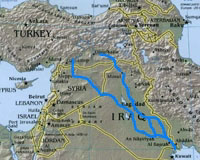| . |  |
. |
Houghton MI (SPX) Jun 16, 2009 It's conventional wisdom in atmospheric science circles: large raindrops fall faster than smaller drops, because they're bigger and heavier. And no raindrop can fall faster than its "terminal speed"-its speed when the downward force of gravity is exactly the same as the upward air resistance. Now two physicists from Michigan Technological University and colleagues at the Universidad Nacional Autonoma de Mexico (National University of Mexico) have discovered that it ain't necessarily so. Some smaller raindrops can fall faster than bigger ones. In fact, they can fall faster than their terminal speed. In other words, they can fall faster than drops that size and weight are supposed to be able to fall. And that could mean that the weatherman has been overestimating how much it rains. The findings of Michigan Tech physics professors Alexander Kostinski and Raymond Shaw-co-authors with Guillermo Montero-Martinez and Fernando Garcia-Garcia on a paper scheduled for publication online June 13, 2009, in the American Geophysical Union's journal Geophysical Research Letters-could improve the accuracy of weather measurement and prediction. The researchers gathered data during natural rainfalls at the Mexico City campus of the National University of Mexico. They studied approximately 64,000 raindrops over three years, using optical array spectrometer probes and a particle analysis and collecting system. They also modified an algorithm or computational formula to analyze the raindrop sizes. They found clusters of raindrops falling faster than their terminal speed, and as the rainfall became heavier, they saw more and more of these unexpectedly speedy drops. They think that the "super-terminal" drops come from the break-up of larger drops, which produces smaller fragments all moving at the same speed as their parent raindrop and faster than the terminal speed predicted by their size. "In the past, people have seen indications of faster-than-terminal drops, but they always attributed it to splashing on the instruments," Shaw explains. He and his colleagues took special precautions to prevent such interference, including collecting data only during extremely calm conditions. Their findings could significantly alter physicists' understanding of the physics of rain. "Existing rain models are based on the assumption that all drops fall at their terminal speed, but our data suggest that this is not the case," Shaw and Kostinski say. If rainfall is measured based on that assumption, large raindrops that are not really there will be recorded. "If we want to forecast weather or rain, we need to understand the rain formation processes and be able to accurately measure the amount of rain," Shaw pointed out. Taking super-terminal raindrops into account could be of real economic benefit, even if it leads only to incremental improvements in precipitation measurement and forecasting. Approximately one-third of the economy-including agriculture, construction and aviation-is directly influenced by the ability to predict precipitation accurately. "And one-third of the economy is a very large sum of money, even during a recession," Shaw remarks.
Share This Article With Planet Earth
Related Links Michigan Technological University Water News - Science, Technology and Politics
 Iraq faces summer water shortage disaster
Iraq faces summer water shortage disasterBaghdad (UPI) Jun 15, 2009 Iraq is headed for an agricultural disaster this summer unless Turkey releases more water from dams on the Euphrates River, an Iraqi minister warned. Water Resources Minister Abdul-Latif Jamal Rasheed told media outlets that officials from Iraq and Turkey, where the Euphrates originates and flows through Syria, must sit down to settle the long-running dispute over river water volumes. ... read more |
|
| The content herein, unless otherwise known to be public domain, are Copyright 1995-2009 - SpaceDaily. AFP and UPI Wire Stories are copyright Agence France-Presse and United Press International. ESA Portal Reports are copyright European Space Agency. All NASA sourced material is public domain. Additional copyrights may apply in whole or part to other bona fide parties. Advertising does not imply endorsement,agreement or approval of any opinions, statements or information provided by SpaceDaily on any Web page published or hosted by SpaceDaily. Privacy Statement |